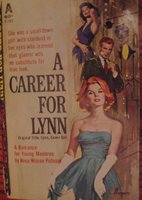The Highest Dream
 "The Highest Dream" by Phyllis A. Whitney, 1956 (see another cover here)
"The Highest Dream" by Phyllis A. Whitney, 1956 (see another cover here)Main character: Lisa Somers
Career: United Nations tour guide
Gael's grade: A, for fun characters and a lively career from a real author. One of the few CRFYM that I've actually read multiple times.
"The Highest Dream" is an exceptional career romance in many ways. Author Phyllis A. Whitney, still alive at 103, is an award-winning writer of some renown. The book is less about the romance and much more about the career, offering a behind-the-scenes view of the UN that is simplistic (the book was meant for young people, after all) but positively glows with hope that this still-new-at-the-time organization can help bring about world peace. As such, Lisa has fewer traumas than most CRFYM heroines, and the plots and characters are as lively as in the best young-adult novel.
Trauma #1: Lisa's dad, Reid Somers, is an acclaimed radio commentator heard worldwide who's writing a book about the UN. Lisa fears that she can never measure up to him and says "I don't want to spend my whole life apologizing because I'm not as good as he is." See, even the traumas are more realistic in this book.
Trauma #2: Lisa rooms with Margie, a high-school dropout who's defensive about her lack of education because previous roommates have lorded their degrees over her. Lisa's kind to her, however, and treats her well, and it doesn't take long for Margie to come out of her shell.
Trauma #3: There really aren't many traumas in this lively book, which focuses a lot on the workings of the UN, the tours Lisa leads, and her earnest attempt to do some good in our big wide world.
Prince Charming: Norman Bond, who works in the UN radio department
What's standing in their way? Lisa thinks Norman prefers Reland Munro, a Scotch-Irish fellow tour guide but Reland finally tells her that Norman prefers Lisa.
How does he come to his senses? He doesn't, Lisa does, with some help from Reland. Again in a real departure from most CRFYMs, Lisa tells Norman "I suspect I want terribly to do some sort of work outside a home." And he pretty much tells her that is OK, saying "It's only lately that I've been coming to the conviction that safety isn't everything in life. Not for nations or for men. Besides, I want a flesh and blood girl, not an image on a pedestal." They're so perfectly reasoned you want to take their words and hit every other CRFYM on the shelf over its head with them.
Signs o' the times:
1) Lisa and Margie are good friends with the family across the hall, and their children convince them to help them with the early days of collecting money for UNICEF as part of their Halloween fun. They carry milk cartons with yellow bands around them, not the official UNICEF containers we had in my day, and they also wear yellow UNICEF ID tags. Awesome. Weirdly though, at least in NYC, they have to be accompanied by a grownup and be sponsored by a church, civic or youth group in order to collect money. Man, that rule went out the window quick.
2) Lisa's other guide friends are from nations all over the world, and they sometimes gently debate and discuss issues in their country. Jeanie Soong's father was killed in events in China, and she fears she can never go home to her beloved country. Asha Dyal, from India, is Hindu, and they discuss spirituality and the caste system. There's a French girl, and an African-American girl (called "Negro" in the book) who is perhaps just as novel to Lisa as those from other countries.
3) Like today, not everyone is sold on the concept of the UN. People on Lisa's tours, and others as well, sometimes argue with her and complain about the amount of money the US spends on the organization.
4) Margie confesses that she got into the habit of eating popcorn because one of her snooty roommates once ranted about"ignorant people who eat popcorn in movie theaters." Wuh?
Quote that says it all:
"Both the European and Asiatic girls at the UN sometimes spoke with a tinge of scorn about American women as wives. American women were spoiled, they said. American men no longer knew how to be men. Lisa had listened uncomfortably to more than one such discussion. An American marriage -- a good one -- was more of a partnership, she felt, with the woman helping to earn and develop herself as an individual, not just as a shadow born to serve her husband. ...It had seemed to Lisa sometimes that even as they criticized, the girls from abroad looked with a certain envy at the freedom and independence of the American woman."
Labels: favorite, Phyllis A. Whitney, UN tour guide


